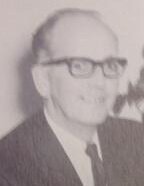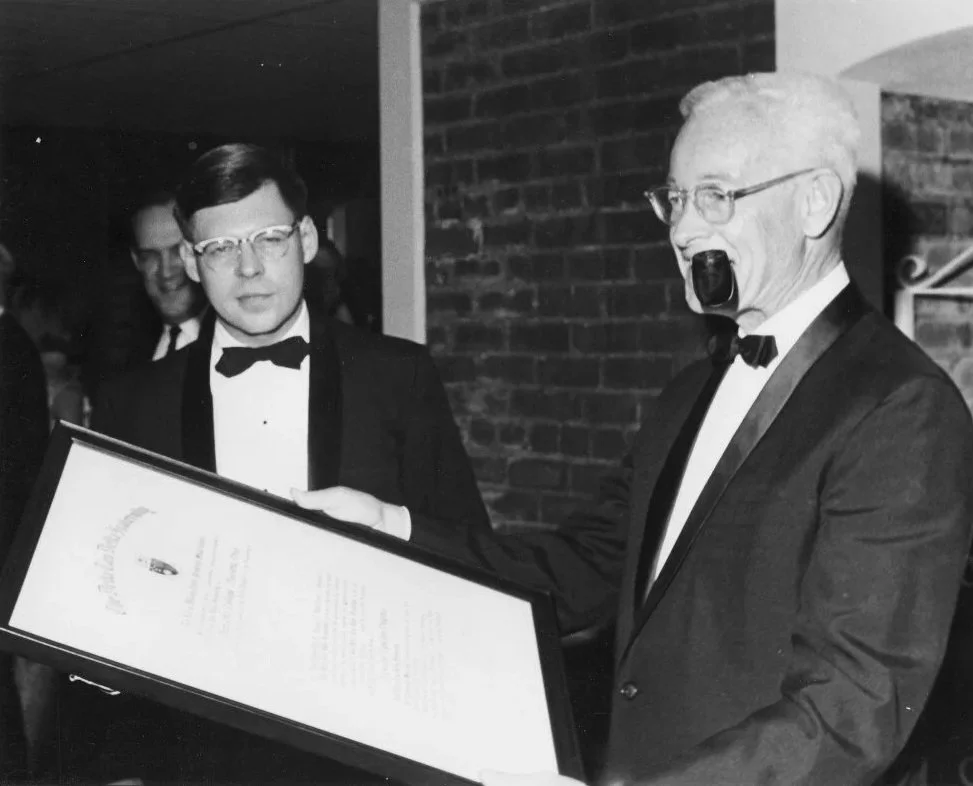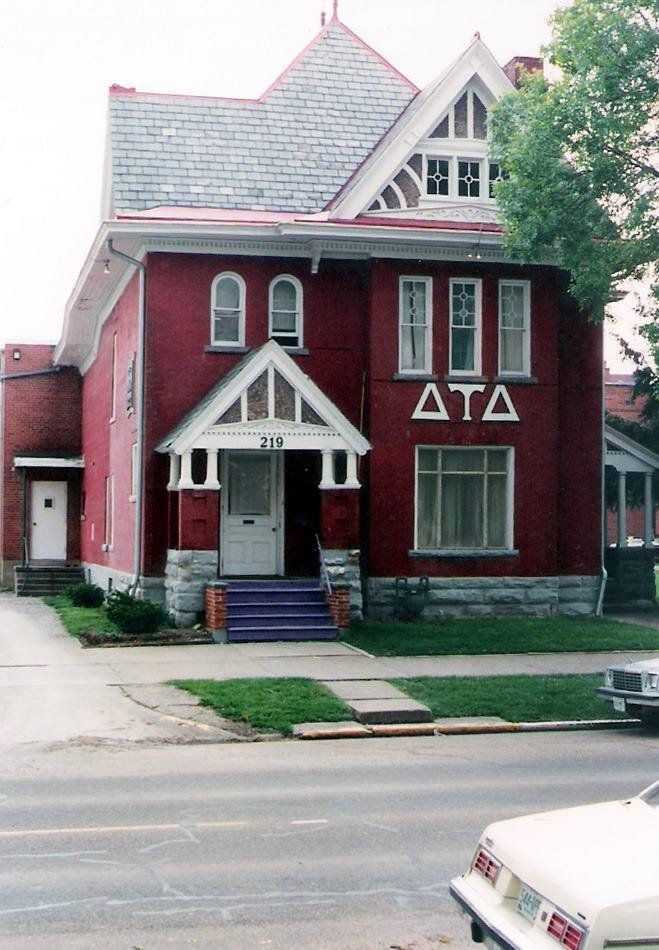Marietta College Dean of Men Walter Hobba, in 1966.
The Beta Delta Epsilon membership pin
The Founding Marietta Delts, on the night of Nov. 23, 1968, when they initiated into Delta Tau Delta and became the Epsilon Upsilon Chapter of the Fraternity.
From Local Fraternity to National Affiliation.
By the autumn of 1966, the fledgling local fraternity had added several pledges, including Rob Weidenfeld ’70, Bruce Miller ’70 and Bill Havens ’69. The small but growing group interviewed potential national fraternities — and they were being interviewed in return.
Among those national fraternities was Delta Tau Delta, a large fraternity which was founded over a century earlier just 100 miles upriver from Marietta, which seemed the most serious about the men at Marietta — and the men at Marietta returned the sentiment. In February of 1967, a Crescent Colony of Delta Tau Delta was established at Marietta College, replacing the Beta Delta Epsilon local fraternity.
From the spring of 1967 into the following school year, the Delt colony continued to pledge new members — and doubled their membership by the spring of 1968. By this time, a college-owned house at 507 Putnam St. (the Bates House) had become home for the Delts; one of the first items of furniture acquired was a large salvaged study table.
In short order, academic trophies were added to the mantelpiece. At the fraternity’s biennial conference, called Karnea, in the summer of 1968 in Kansas City, the Marietta Delt Crescent Colony’s petition for Chapter status was approved. By the fall of 1968, the colony had fulfilled its requirements and was ready for installation into Delta Tau Delta.
On Saturday, November 23, 1968, the Epsilon Upsilon Chapter of Delta Tau Delta International Fraternity was established at Marietta College — the Fraternity’s 101st Chapter.
On that night, 28 men were initiated as Marietta Delts. Among this group were recent Marietta graduates who had been members of Beta Delta Epsilon as well as Marietta College Professor of History Dr. R.L. Jones, the Chapter’s first Faculty Advisor.
Delts from nearby Chapters at Ohio University (Beta Chapter), Ohio State University (Beta Phi), University of Cincinnati (Gamma Xi), West Virginia University (Gamma Delta) and Case Western Reserve (Zeta) alternated in peforming the intstallation and initiation rituals, which were held in the domed second-floor faculty lounge of the Irvine Administration Building.
Among the Delts helping to install the Chapter and initiate the Marietta Delts was Marietta native Robert Ferguson ’71 of Gamma Xi, who later became the Marietta Delt Chapter Advisor.
Robert Hartford, president of Delta Tau Delta International Fraternity, presented the Chapter’s charter at an initiation banquet that followed at the Club Continental. A formal dance followed the banquet at the Knights of Columbus.
In 1984, the college moved the Delts from 507 Putnam to 219 Fourth St. (the Williams House), which had just become vacant after the Marietta chapter of the Alpha Sigma Tau sorority collapsed. (Before Alpha Sigma Tau, the Alpha Gamma Delta sorority, and then earlier, the Alpha Tau Omega fraternity, called 219 Fourth St. home.)
Following a national trend in the 1990s, the Greek system at Marietta College floundered; one sorority and four fraternity chapters at Marietta closed during this time.
Marietta’s chapter of Delta Tau Delta has both struggled (facing collapse in both the early 1980s and in the late 1990s) and thrived (winning Delta Tau Delta’s top honor — the Hugh Shields Award for Chapter Excellence in 1990, 1992, 1993, 2008, 2011 and 2012). But most importantly, Marietta’s Delt chapter has survived for 57 years.
From Local Fraternity to National Affiliation.
In the spring of 1966, Marietta College Dean of Men Walter Hobba announced to the men of Marietta College that a new social fraternity was welcome to join the college’s Greek-letter community.
At this time, there were six women’s sororities and six men’s fraternities — of that total, three sorority chapters and two fraternity chapters were less than 10 years old. With nearly 2,000 undergraduates in the mid-1960s, Marietta College’s enrollment was at a record high.
A group of college men who had declined to join any of the established fraternities expressed an interest in Hobba’s offer to become the seventh fraternity on campus.
From the top, Beta Theta Pi, Phi Delta Theta, and Sigma Alpha Epsilon
Having recently returned from a conference of the National Interfraternity Council, Hobba had captured the attention of three national fraternities interested in starting a chapter at Marietta: Beta Theta Pi, Phi Delta Theta, and Sigma Alpha Epsilon.
On March 7, 1966, a local fraternity was established to affiliate with a national fraternity within two years. Hobba, with the assistance of Dean of Students Merrill Patterson and College President Dr. Frank Duddy Jr., initiated 14 men.
That local fraternity took the name Beta Delta Epsilon — chosen in recognition of the three national fraternities under consideration then. Beta Delta Epsilon’s motto was “That all may be one.”
The initial group of 14 Marietta College men who formed Beta Delta Epsilon were Ken Kavula ’69, Tom Robinson ’69, Gregory Maloof ’67, William Warner ’68, Peter Rosenberger ’67, Steve Newton ’66, Joseph Cohn ’69, Albert Mason ’68, David Dessen ’69, Franklin Hirsch ’69, Charles Baker ’67, Marc Kattleman ’69, Mike Rothman ’69 and Lee St. Clair ’67.
A house at 515 Butler St. (called the Strecker House), across from Dorothy Webster Hall became Beta Delta Epsilon’s first meeting place, but the BDE members did not live there. The Strecker House, which later became home to the Alpha Tau Omega and Tau Kappa Epsilon fraternities, was demolished in the mid-1990s to make way for the Dyson Baudo Recreation Center.
The Bates House, at 507 Putnam St., in the 1970s.
The Williams House, 219 Fourth Street, in 1989, with its iconic purple steps, lead-based red paint and disintegrating sandstone foundation.
The Marietta Delt Chapter in 2013 shows off its Hugh Shields Award for Chapter Excellence — the highest award that Delta Tau Delta can bestow upon a Chapter. The Hugh Shields Award is a flag that a winning Chapter is allowed to keep for a year. After winning five Hugh Shields Awards, a Chapter is presented with a flag that it keep permanently. The flag on the left is the Hugh Shields Award the Chapter won for 2012. The flag on the right is for the Hugh Shields Awards the Chapter won in 1990, 1992, 1993, 2008 and 2011.






